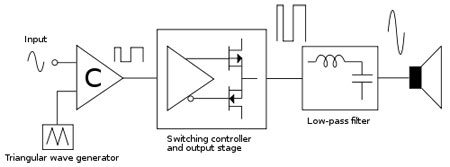Digital Divide


For those who aren't familiar with the basic technology, Class D amps typically accept an analog signal, which is converted into a series of high-frequency pulses with constant amplitude and variable widths that represent the waveshape of the input signal. This process is called pulse-width modulation (PWM) and is inherently digital in nature. Output transistors then generate a high-power replica of the pulses, which are filtered to remove the pulse frequency and its harmonics in order to reconstruct the original waveshape at a higher amplitude than the input signal. The circuitry that controls the process can be analog or digital, leading to some confusion about exactly what qualifies as a "digital" amp.

By contrast, the M2 was designed to accept PCM digital-audio signals and convert them to PWM, keeping the signals in the digital domain all the way to the final output—hence NAD's designation as a Direct Digital Amplifier—where they are filtered to reconstruct the corresponding analog signals that are then fed to the speakers. Among the innovations embodied in the M2 is a digital feedback loop that compares the PWM output with the idealized pulse shape, creating an "error" signal that is used to correct subsequent modulation cycles.

The result of this and other engineering advances is said to be vanishingly low distortion and noise, virtually no jitter, and useful resolution down to –135dBFS! In addition to the digital inputs, balanced and single-ended analog inputs are provided, and ultra-high-resolution analog-to-digital converters keep the performance of the analog inputs within 1dB of the digital inputs for all measurements.
The specs tell an impressive story. The M2's power output is rated at 250Wpc into 8Ω or 4Ω with only 0.004% THD from 20Hz to 20kHz, a range that also defines the amp's frequency response (±0.3dB). Most amps output more power into lower speaker impedances, but NAD designs its amps to maintain the same power because many speakers today exhibit a nominal impedance lower than 8Ω. All this can be yours for $6000—not cheap, to be sure, but worth every penny if its real-world performance matches NAD's claims.
- Log in or register to post comments






























































